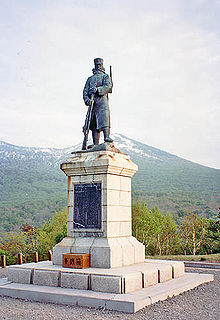

This article has multiple issues. Please help improve it or discuss these issues on the talk page. (Learn how and when to remove these template messages)
|

The Mount Hakkōda disaster (八甲田雪中行軍遭難事件, Hakkōda Settchū Kōgun Sōnan Jiken) occurred on 23 January 1902, when a group of Imperial Japanese Army soldiers became lost in a blizzard on the Hakkōda MountainsinAomori Prefecture in northern Honshu, Japan, en-route to Tashiro Hot Spring located in the Hakkōda Mountains. The 199 deaths during a single ascent make it the most lethal disaster in the modern history of mountain climbing.
The world's worst mountaineering disaster, according to the Guinness Book of Records, is the Lenin Peak disaster, in which 43 people died.[1] In the case of the Hakkōda Disaster, although it was a military disaster, they were not training for shooting or combat training. They were simply climbing a winter mountain to reach their destination, a hot spring. If mountaineering is defined as aiming for a mountain destination with the itinerary and route planned in advance, then the Hakkōda Disaster is the deadliest mountain disaster in the world, with 199 fatalities in a single climb.[2]
In the prelude to the Russo-Japanese War, the Imperial Japanese Army deemed it necessary to secure a route through the Hakkōda Mountains in the event that roads and railways were destroyed by shelling of the Aomori coastline by the Imperial Russian Navy during wintertime. Training in movement during winter conditions was also deemed necessary in light of a potential war with Russia, so a wintertime crossing of the Hakkōda Mountains was planned.
The IJA's 8th Division's Fifth Infantry Regiment was stationed in the city of Aomori. The western side of the Ou Mountains has heavy monsoons and little sunshine which leads to heavy snowfall.[3][4] The 210-man unit that made the march into the Hakkōda Mountains in the snow was selected from the 3,000-man Fifth Infantry Regiment, but consisted of many men who originated from a region with little snow and lacked experience in climbing snowy mountains. The unit also did not use local guides.
The troops, slowed by their heavy supply sleds, set out from Aomori at 6:55 a.m. on 23 January 1902. Their objective was Tashiro Hot Spring [d] located 20 kilometres (12 mi) away in the Hakkōda Mountains. At 4 p.m. on 23 January, the unit reached the summit of Umatateba (732 metres (2,402 ft)), which was only four kilometers from the first day's objective, Tashiro Hot Spring.

On day three, 25 January 1902, the weather changed suddenly, and a temperature of −41 °C (−42 °F) was observed—the lowest in Japanese weather observation history, and there was an enormous low-pressure system above the Hakkōda Mountains. In the deep snow and blizzard, the soldiers wandered the northeast slope of the mountains for several days.
The unit missed the expected return date on 24 January, but the regimental HQ at Aomori remained optimistic until 26 January, when a 60-man rescue party to track and find the missing men was dispatched.
On 27 January, the fifth day since their departure, Corporal Fusanosuke Gotō, standing buried in the snow, became the first survivor discovered by the rescue party. The details of disaster which struck the unit marching through the Hakkōda Mountains were established based on Corporal Gotō's testimony. The 5th Regiment and the 8th Division finally were placed on full-alert and launched major search-and-rescue/recover operations which lasted for months and involved tens of thousands of soldiers and villagers. The last survivor was found on 2 February and the last body was recovered on 28 May.
In total, 193 of the 210 men froze to death en route. A further six died within two months after rescue. Eight out of 11 survivors had to have limbs amputated due to frostbite, including Gotō.
Journalist Koshu Ogasawara [ja] spent many years covering the Hakkōda disaster. In 1971, after receiving numerous documents from Ogasawara, novelist Jirō Nitta published Death March on Mount Hakkōda:(八甲田山死の彷徨, Hakkōdasan shi no hōkō), a semi-fictional account of the disaster. James Westerhoven translated the book into English.[5] The screenwriter Shinobu Hashimoto, who is also famous for Akira Kurosawa's Seven Samurai, adapted the novel and produced the 1977 movie Mount Hakkoda (八甲田山). However, both the novel and the film are partly fictionalized, and there are many discrepancies with the facts.
In 1978, a Hakkōda Disaster museum opened next to the army cemetery in Aomori.[6]
Mt. Hakkoda (The world's worst mountaineering disaster – 八甲田山 世界最大の山岳遭難事故), a film based on historical facts, was released in 2014.
40°42′24″N 140°52′22″E / 40.70667°N 140.87278°E / 40.70667; 140.87278